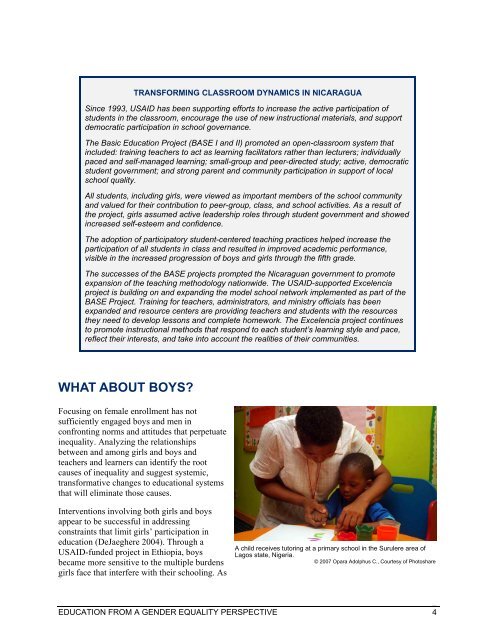Education from a Gender Equality Perspective - United Nations Girls ...
Education from a Gender Equality Perspective - United Nations Girls ...
Education from a Gender Equality Perspective - United Nations Girls ...
You also want an ePaper? Increase the reach of your titles
YUMPU automatically turns print PDFs into web optimized ePapers that Google loves.
TRANSFORMING CLASSROOM DYNAMICS IN NICARAGUA<br />
Since 1993, USAID has been supporting efforts to increase the active participation of<br />
students in the classroom, encourage the use of new instructional materials, and support<br />
democratic participation in school governance.<br />
The Basic <strong>Education</strong> Project (BASE I and II) promoted an open-classroom system that<br />
included: training teachers to act as learning facilitators rather than lecturers; individually<br />
paced and self-managed learning; small-group and peer-directed study; active, democratic<br />
student government; and strong parent and community participation in support of local<br />
school quality.<br />
All students, including girls, were viewed as important members of the school community<br />
and valued for their contribution to peer-group, class, and school activities. As a result of<br />
the project, girls assumed active leadership roles through student government and showed<br />
increased self-esteem and confidence.<br />
The adoption of participatory student-centered teaching practices helped increase the<br />
participation of all students in class and resulted in improved academic performance,<br />
visible in the increased progression of boys and girls through the fifth grade.<br />
The successes of the BASE projects prompted the Nicaraguan government to promote<br />
expansion of the teaching methodology nationwide. The USAID-supported Excelencia<br />
project is building on and expanding the model school network implemented as part of the<br />
BASE Project. Training for teachers, administrators, and ministry officials has been<br />
expanded and resource centers are providing teachers and students with the resources<br />
they need to develop lessons and complete homework. The Excelencia project continues<br />
to promote instructional methods that respond to each student’s learning style and pace,<br />
reflect their interests, and take into account the realities of their communities.<br />
WHAT ABOUT BOYS?<br />
Focusing on female enrollment has not<br />
sufficiently engaged boys and men in<br />
confronting norms and attitudes that perpetuate<br />
inequality. Analyzing the relationships<br />
between and among girls and boys and<br />
teachers and learners can identify the root<br />
causes of inequality and suggest systemic,<br />
transformative changes to educational systems<br />
that will eliminate those causes.<br />
Interventions involving both girls and boys<br />
appear to be successful in addressing<br />
constraints that limit girls’ participation in<br />
education (DeJaeghere 2004). Through a<br />
USAID-funded project in Ethiopia, boys<br />
became more sensitive to the multiple burdens<br />
girls face that interfere with their schooling. As<br />
A child receives tutoring at a primary school in the Surulere area of<br />
Lagos state, Nigeria.<br />
© 2007 Opara Adolphus C., Courtesy of Photoshare<br />
EDUCATION FROM A GENDER EQUALITY PERSPECTIVE 4

















